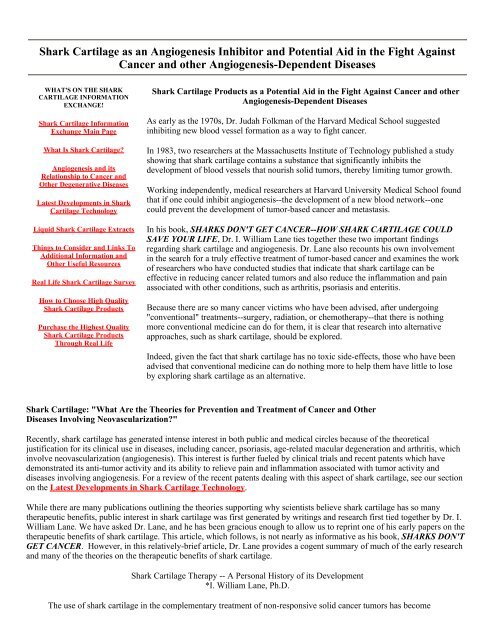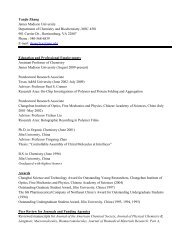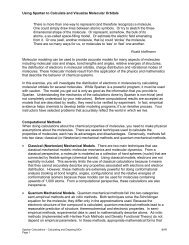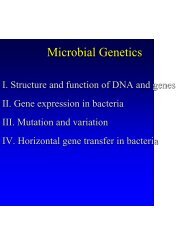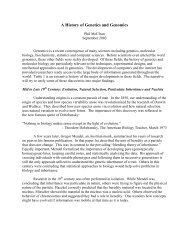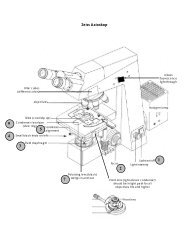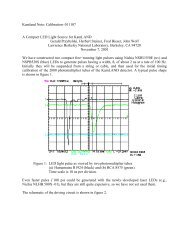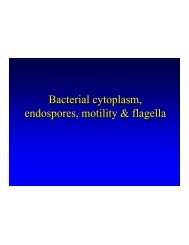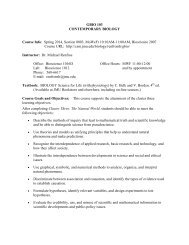Shark Cartilage as an Angiogenesis Inhibitor and Potential Aid in ...
Shark Cartilage as an Angiogenesis Inhibitor and Potential Aid in ...
Shark Cartilage as an Angiogenesis Inhibitor and Potential Aid in ...
You also want an ePaper? Increase the reach of your titles
YUMPU automatically turns print PDFs into web optimized ePapers that Google loves.
<strong>Shark</strong> <strong>Cartilage</strong> <strong>as</strong> <strong>an</strong> <strong>Angiogenesis</strong> <strong>Inhibitor</strong> <strong>an</strong>d <strong>Potential</strong> <strong>Aid</strong> <strong>in</strong> the Fight Aga<strong>in</strong>st<br />
C<strong>an</strong>cer <strong>an</strong>d other <strong>Angiogenesis</strong>-Dependent Dise<strong>as</strong>es<br />
WHAT'S ON THE SHARK<br />
CARTILAGE INFORMATION<br />
EXCHANGE!<br />
<strong>Shark</strong> <strong>Cartilage</strong> Information<br />
Exch<strong>an</strong>ge Ma<strong>in</strong> Page<br />
What Is <strong>Shark</strong> <strong>Cartilage</strong>?<br />
<strong>Angiogenesis</strong> <strong>an</strong>d its<br />
Relationship to C<strong>an</strong>cer <strong>an</strong>d<br />
Other Degenerative Dise<strong>as</strong>es<br />
Latest Developments <strong>in</strong> <strong>Shark</strong><br />
<strong>Cartilage</strong> Technology<br />
Liquid <strong>Shark</strong> <strong>Cartilage</strong> Extracts<br />
Th<strong>in</strong>gs to Consider <strong>an</strong>d L<strong>in</strong>ks To<br />
Additional Information <strong>an</strong>d<br />
Other Useful Resources<br />
Real Life <strong>Shark</strong> <strong>Cartilage</strong> Survey<br />
How to Choose High Quality<br />
<strong>Shark</strong> <strong>Cartilage</strong> Products<br />
Purch<strong>as</strong>e the Highest Quality<br />
<strong>Shark</strong> <strong>Cartilage</strong> Products<br />
Through Real Life<br />
<strong>Shark</strong> <strong>Cartilage</strong> Products <strong>as</strong> a <strong>Potential</strong> <strong>Aid</strong> <strong>in</strong> the Fight Aga<strong>in</strong>st C<strong>an</strong>cer <strong>an</strong>d other<br />
<strong>Angiogenesis</strong>-Dependent Dise<strong>as</strong>es<br />
As early <strong>as</strong> the 1970s, Dr. Judah Folkm<strong>an</strong> of the Harvard Medical School suggested<br />
<strong>in</strong>hibit<strong>in</strong>g new blood vessel formation <strong>as</strong> a way to fight c<strong>an</strong>cer.<br />
In 1983, two researchers at the M<strong>as</strong>sachusetts Institute of Technology published a study<br />
show<strong>in</strong>g that shark cartilage conta<strong>in</strong>s a subst<strong>an</strong>ce that signific<strong>an</strong>tly <strong>in</strong>hibits the<br />
development of blood vessels that nourish solid tumors, thereby limit<strong>in</strong>g tumor growth.<br />
Work<strong>in</strong>g <strong>in</strong>dependently, medical researchers at Harvard University Medical School found<br />
that if one could <strong>in</strong>hibit <strong>an</strong>giogenesis--the development of a new blood network--one<br />
could prevent the development of tumor-b<strong>as</strong>ed c<strong>an</strong>cer <strong>an</strong>d met<strong>as</strong>t<strong>as</strong>is.<br />
In his book, SHARKS DON'T GET CANCER--HOW SHARK CARTILAGE COULD<br />
SAVE YOUR LIFE, Dr. I. William L<strong>an</strong>e ties together these two import<strong>an</strong>t f<strong>in</strong>d<strong>in</strong>gs<br />
regard<strong>in</strong>g shark cartilage <strong>an</strong>d <strong>an</strong>giogenesis. Dr. L<strong>an</strong>e also recounts his own <strong>in</strong>volvement<br />
<strong>in</strong> the search for a truly effective treatment of tumor-b<strong>as</strong>ed c<strong>an</strong>cer <strong>an</strong>d exam<strong>in</strong>es the work<br />
of researchers who have conducted studies that <strong>in</strong>dicate that shark cartilage c<strong>an</strong> be<br />
effective <strong>in</strong> reduc<strong>in</strong>g c<strong>an</strong>cer related tumors <strong>an</strong>d also reduce the <strong>in</strong>flammation <strong>an</strong>d pa<strong>in</strong><br />
<strong>as</strong>sociated with other conditions, such <strong>as</strong> arthritis, psori<strong>as</strong>is <strong>an</strong>d enteritis.<br />
Because there are so m<strong>an</strong>y c<strong>an</strong>cer victims who have been advised, after undergo<strong>in</strong>g<br />
"conventional" treatments--surgery, radiation, or chemotherapy--that there is noth<strong>in</strong>g<br />
more conventional medic<strong>in</strong>e c<strong>an</strong> do for them, it is clear that research <strong>in</strong>to alternative<br />
approaches, such <strong>as</strong> shark cartilage, should be explored.<br />
Indeed, given the fact that shark cartilage h<strong>as</strong> no toxic side-effects, those who have been<br />
advised that conventional medic<strong>in</strong>e c<strong>an</strong> do noth<strong>in</strong>g more to help them have little to lose<br />
by explor<strong>in</strong>g shark cartilage <strong>as</strong> <strong>an</strong> alternative.<br />
<strong>Shark</strong> <strong>Cartilage</strong>: "What Are the Theories for Prevention <strong>an</strong>d Treatment of C<strong>an</strong>cer <strong>an</strong>d Other<br />
Dise<strong>as</strong>es Involv<strong>in</strong>g Neov<strong>as</strong>cularization?"<br />
Recently, shark cartilage h<strong>as</strong> generated <strong>in</strong>tense <strong>in</strong>terest <strong>in</strong> both public <strong>an</strong>d medical circles because of the theoretical<br />
justification for its cl<strong>in</strong>ical use <strong>in</strong> dise<strong>as</strong>es, <strong>in</strong>clud<strong>in</strong>g c<strong>an</strong>cer, psori<strong>as</strong>is, age-related macular degeneration <strong>an</strong>d arthritis, which<br />
<strong>in</strong>volve neov<strong>as</strong>cularization (<strong>an</strong>giogenesis). This <strong>in</strong>terest is further fueled by cl<strong>in</strong>ical trials <strong>an</strong>d recent patents which have<br />
demonstrated its <strong>an</strong>ti-tumor activity <strong>an</strong>d its ability to relieve pa<strong>in</strong> <strong>an</strong>d <strong>in</strong>flammation <strong>as</strong>sociated with tumor activity <strong>an</strong>d<br />
dise<strong>as</strong>es <strong>in</strong>volv<strong>in</strong>g <strong>an</strong>giogenesis. For a review of the recent patents deal<strong>in</strong>g with this <strong>as</strong>pect of shark cartilage, see our section<br />
on the Latest Developments <strong>in</strong> <strong>Shark</strong> <strong>Cartilage</strong> Technology.<br />
While there are m<strong>an</strong>y publications outl<strong>in</strong><strong>in</strong>g the theories support<strong>in</strong>g why scientists believe shark cartilage h<strong>as</strong> so m<strong>an</strong>y<br />
therapeutic benefits, public <strong>in</strong>terest <strong>in</strong> shark cartilage w<strong>as</strong> first generated by writ<strong>in</strong>gs <strong>an</strong>d research first tied together by Dr. I.<br />
William L<strong>an</strong>e. We have <strong>as</strong>ked Dr. L<strong>an</strong>e, <strong>an</strong>d he h<strong>as</strong> been gracious enough to allow us to repr<strong>in</strong>t one of his early papers on the<br />
therapeutic benefits of shark cartilage. This article, which follows, is not nearly <strong>as</strong> <strong>in</strong>formative <strong>as</strong> his book, SHARKS DON'T<br />
GET CANCER. However, <strong>in</strong> this relatively-brief article, Dr. L<strong>an</strong>e provides a cogent summary of much of the early research<br />
<strong>an</strong>d m<strong>an</strong>y of the theories on the therapeutic benefits of shark cartilage.<br />
<strong>Shark</strong> <strong>Cartilage</strong> Therapy -- A Personal History of its Development<br />
*I. William L<strong>an</strong>e, Ph.D.<br />
The use of shark cartilage <strong>in</strong> the complementary treatment of non-responsive solid c<strong>an</strong>cer tumors h<strong>as</strong> become
widely used worldwide; approximately 25,000 patients are us<strong>in</strong>g the therapy today. Initially, shark cartilage<br />
usage w<strong>as</strong> strictly patient-driven, but more recently it is suggested by doctors when conventional c<strong>an</strong>cer therapies<br />
have not helped patients. Certa<strong>in</strong>ly, most oncologists will agree that, despite the progress <strong>in</strong> treat<strong>in</strong>g c<strong>an</strong>cer, the<br />
lack of a real breakthrough is frustrat<strong>in</strong>g <strong>an</strong>d m<strong>an</strong>y oncologists state they themselves would not use chemotherapy<br />
if they develop c<strong>an</strong>cer. In fact, m<strong>an</strong>y calls that come <strong>in</strong> to me are from physici<strong>an</strong>s on behalf of themselves or<br />
members of their families. Yet, they are reluct<strong>an</strong>t to recommend shark cartilage to patients because of concerns<br />
relat<strong>in</strong>g to malpractice suits.<br />
The book <strong>Shark</strong>s Don't Get C<strong>an</strong>cer, which I coauthored, is now published <strong>in</strong> more th<strong>an</strong> 15 l<strong>an</strong>guages <strong>an</strong>d h<strong>as</strong><br />
been widely read, <strong>an</strong>d the therapeutic regimen is followed by countless people who felt hopeless about surviv<strong>in</strong>g<br />
their c<strong>an</strong>cers. I like to th<strong>in</strong>k that the correct, <strong>an</strong>d I must stress the word correct, use of a good shark cartilage, <strong>in</strong><br />
adequate dosage levels, h<strong>as</strong> helped thous<strong>an</strong>ds of such patients. <strong>Shark</strong> cartilage therapy h<strong>as</strong> caught the attention of<br />
all levels of practitioners, but it is hard for m<strong>an</strong>y of them to believe that so simple <strong>an</strong> approach c<strong>an</strong> work with<br />
such a stubborn dise<strong>as</strong>e. However, despite the controversy, m<strong>an</strong>y who have tried <strong>an</strong>d correctly used shark<br />
cartilage are talk<strong>in</strong>g about it <strong>in</strong> highly positive terms.<br />
Much more research h<strong>as</strong> been undertaken th<strong>an</strong> most people realize <strong>an</strong>d the undisputable fact is that the Food <strong>an</strong>d<br />
Drug Adm<strong>in</strong>istration (FDA)--after carefully weigh<strong>in</strong>g the cl<strong>in</strong>ical evidence--h<strong>as</strong> recently gr<strong>an</strong>ted full<br />
Investigational New Drug (IND) permission for ph<strong>as</strong>e 2 cl<strong>in</strong>ical trials on both adv<strong>an</strong>ced nonresponsive prostate<br />
c<strong>an</strong>cer <strong>as</strong> well <strong>as</strong> on adv<strong>an</strong>ced Kaposi's sarcoma. This lends material credence to the work. These ph<strong>as</strong>e 2 trials<br />
will soon be under way <strong>in</strong> one of the most prestigious medical centers <strong>in</strong> the Midwest. To date, I have personally<br />
funded the research, so <strong>in</strong>expensive facilities <strong>an</strong>d groups had to be found. Still, the unusually large <strong>an</strong>d long<br />
positive responses should partially offset the lack of peer review.<br />
This history of my work with shark cartilage <strong>as</strong> well <strong>as</strong> the benchmarks that orig<strong>in</strong>ally opened the door of my<br />
curiosity will expla<strong>in</strong> why <strong>an</strong>d how <strong>in</strong>terest developed. As a student at Cornell <strong>an</strong>d later at Rutgers I had the<br />
good fortune to be exposed to the th<strong>in</strong>k<strong>in</strong>g of two Nobel Laureates, James B. Sumner, Ph.D., <strong>an</strong>d Selm<strong>an</strong><br />
Waksm<strong>an</strong>, M.D., Ph.D. I learned to look for the unusual <strong>an</strong>d <strong>as</strong>k "Why?" As a so-called fisheries expert, I first<br />
became <strong>in</strong>terested <strong>in</strong> the shark when the Shah of Ir<strong>an</strong> <strong>as</strong>ked me to look <strong>in</strong>to develop<strong>in</strong>g, for him, a possible<br />
fishery <strong>in</strong> the Persi<strong>an</strong> Gulf, <strong>an</strong> area that abounds <strong>in</strong> shark. As I read <strong>an</strong>d <strong>in</strong>quired about the topic, it became<br />
obvious that this <strong>in</strong>credible liv<strong>in</strong>g mach<strong>in</strong>e called shark had survived literally unch<strong>an</strong>ged for 300 million years; it<br />
w<strong>as</strong> a prehistoric creature, <strong>an</strong>d it rarely got c<strong>an</strong>cer even though almost all other sea creatures get a lot of c<strong>an</strong>cer,<br />
especially s<strong>in</strong>ce pollution of the oce<strong>an</strong>s h<strong>as</strong> <strong>in</strong>cre<strong>as</strong>ed materially.<br />
The "Why?" w<strong>as</strong> partially <strong>an</strong>swered when I met, <strong>an</strong>d read the work of, John Prudden, M.D., who w<strong>as</strong> work<strong>in</strong>g<br />
with bov<strong>in</strong>e cartilage <strong>as</strong> <strong>an</strong> immune stimulator, wound heal<strong>in</strong>g, <strong>an</strong>d <strong>an</strong>tic<strong>an</strong>cer agent. However, the real "Why?"<br />
w<strong>as</strong> <strong>an</strong>swered when, <strong>in</strong> 1983, Anne Lee, Ph.D., <strong>an</strong>d Robert L<strong>an</strong>ger, Ph.D.,5 published a paper that illustrated that<br />
shark cartilage <strong>in</strong>hibited <strong>an</strong>giogenesis <strong>an</strong>d tumor growth. I learned of this study via CNN NEWS, which, along<br />
with m<strong>an</strong>y popular newspapers <strong>an</strong>d TV programs, publicized this <strong>in</strong>credible response. I immediately visited Dr.<br />
L<strong>an</strong>ger at M<strong>as</strong>sachusetts Institute of Technology <strong>an</strong>d he told me that, although his work w<strong>as</strong> done with a complex<br />
extract, whole but undenatured shark cartilage would probably produce <strong>an</strong> even better effect. Dr. L<strong>an</strong>ger later<br />
denied hav<strong>in</strong>g this conversation, but it took place <strong>in</strong> his office <strong>in</strong> September 1983 <strong>an</strong>d it w<strong>as</strong> the start<strong>in</strong>g po<strong>in</strong>t of<br />
my piqued <strong>in</strong>terest. I then read much of the work of Judah Folkm<strong>an</strong>, M.D., on the theory of <strong>in</strong>hibit<strong>in</strong>g<br />
<strong>an</strong>giogenesis <strong>as</strong> a mech<strong>an</strong>ism to stop tumor growth. I also read the work of <strong>an</strong>other Harvard researcher which<br />
said that the av<strong>as</strong>cular tissues were the logical place to f<strong>in</strong>d the <strong>an</strong>giogenic <strong>in</strong>hibitors. B<strong>as</strong>ed on the published<br />
work just cited <strong>an</strong>d my own desire to develop a practical "how <strong>an</strong>d why," the concept beh<strong>in</strong>d the shark cartilage<br />
product developed.<br />
<strong>Cartilage</strong> Theory Gets Support<br />
By 1984, I w<strong>as</strong> able to br<strong>in</strong>g 200 pounds of frozen cle<strong>an</strong> shark cartilage to the United States from P<strong>an</strong>ama.<br />
Work<strong>in</strong>g for four years with the orig<strong>in</strong>al 200 pounds of shark cartilage, plus other shark cartilage <strong>as</strong> needed, <strong>an</strong>d<br />
with the <strong>as</strong>sist<strong>an</strong>ce of friends <strong>in</strong> the process<strong>in</strong>g <strong>in</strong>dustry, I w<strong>as</strong> able to learn how to dry best without denatur<strong>in</strong>g,<br />
pulverize with m<strong>in</strong>imal heat (a major feat), <strong>an</strong>d encapsulate (often <strong>in</strong> my own kitchen). Via the chicken<br />
chorioall<strong>an</strong> membr<strong>an</strong>e <strong>as</strong>say, a crude <strong>as</strong>say to me<strong>as</strong>ure <strong>in</strong>hibition of <strong>an</strong>giogenesis, I could me<strong>as</strong>ure my progress.<br />
By 1987 George Escher, M.D., <strong>in</strong>troduced my work to Henri Tagnon, M.D.,who headed the Institut Jules Bordet<br />
<strong>in</strong> Brussels, Belgium, a major c<strong>an</strong>cer research center <strong>in</strong> Europe. After listen<strong>in</strong>g to my theory, Dr. Tagnon gave me<br />
my first break when he offered, <strong>in</strong> connection with Dr. Gh<strong>an</strong>em At<strong>as</strong>si, Ph.D., to run a xenograph <strong>in</strong> nude mice. I<br />
still remember Dr. Tagnon's words after he <strong>an</strong>d Dr. At<strong>as</strong>si heard my story: "This is too good to believe but it also
is too good not to believe." After runn<strong>in</strong>g a rat toxicity study, they r<strong>an</strong> <strong>an</strong>imal studies that culm<strong>in</strong>ated <strong>in</strong> a<br />
xenograph us<strong>in</strong>g nude mice <strong>in</strong> which MEXF514 hum<strong>an</strong> mel<strong>an</strong>oma w<strong>as</strong> <strong>in</strong>duced subcut<strong>an</strong>eously <strong>an</strong>d my shark<br />
cartilage preparation w<strong>as</strong> given orally <strong>in</strong> suspension. Sal<strong>in</strong>e w<strong>as</strong> given orally to the control mice. The results<br />
showed almost complete tumor <strong>in</strong>hibition by the orally adm<strong>in</strong>istered shark cartilage.<br />
This <strong>an</strong>imal work led to a study <strong>in</strong> Mexico at the Hospital Ernesto Contrer<strong>as</strong>, where there were eight nonpay<strong>in</strong>g,<br />
term<strong>in</strong>al c<strong>an</strong>cer patients (seven women <strong>an</strong>d one m<strong>an</strong>), whose c<strong>an</strong>cers had failed to respond to other therapies. Six<br />
different types of tumors were presented. This work, published by Ernesto Contrer<strong>as</strong>, M.D., <strong>an</strong>d me, showed<br />
major responses <strong>in</strong> seven of the eight patients: five were tumor-free, two had <strong>an</strong> 80 percent tumor reduction.<br />
There w<strong>as</strong> only one death <strong>in</strong> eleven weeks. The only therapy w<strong>as</strong> a special high potency shark cartilage material<br />
made from shark f<strong>in</strong> fibers. This product conta<strong>in</strong>ed 91 percent prote<strong>in</strong>, 8 percent water, <strong>an</strong>d, at most, only 1<br />
percent carbohydrate. The product w<strong>as</strong> adm<strong>in</strong>istered rectally at the rate of 30 gm/patient daily <strong>in</strong> two equal doses.<br />
Unfortunately, because of both a lack of funds <strong>an</strong>d sufficient test material, no follow-up w<strong>as</strong> undertaken to<br />
determ<strong>in</strong>e adv<strong>an</strong>ced survival <strong>as</strong> w<strong>as</strong> later done <strong>in</strong> the Cub<strong>an</strong> study.<br />
The first Mexic<strong>an</strong> study led to a second study at a second cl<strong>in</strong>ic <strong>in</strong> Mexico, the Hoxsey Cl<strong>in</strong>ic, where, under the<br />
control of Roscoe V<strong>an</strong> Z<strong>an</strong>dt, M.D., eight bre<strong>as</strong>t c<strong>an</strong>cer patients were given shark cartilage orally at the rate of 60<br />
gm/ patient/day. After eight weeks all of the tumors had signific<strong>an</strong>tly reduced <strong>in</strong> size. A special herbal tonic w<strong>as</strong><br />
adm<strong>in</strong>istered along with the shark cartilage. No other therapies were undertaken. In three c<strong>as</strong>es the tumors had<br />
become encapsulated <strong>an</strong>d <strong>in</strong> two c<strong>as</strong>es, where the tumors had been attached to the chest wall, they had become<br />
detached <strong>an</strong>d free-float<strong>in</strong>g. These results were not published <strong>in</strong> medical journals but were reported <strong>in</strong> my book.<br />
Because shark f<strong>in</strong> is very expensive <strong>an</strong>d scarce, we decided to use whole shark cartilage product <strong>in</strong> the Hoxsey<br />
study but at double the dosage level used <strong>in</strong> the earlier Contrer<strong>as</strong> study. The active prote<strong>in</strong> fibers <strong>in</strong> shark f<strong>in</strong> <strong>an</strong>d<br />
shark cartilage were the same, but <strong>in</strong> the cartilage the prote<strong>in</strong> fibers were diluted with a matrix of<br />
calcium/phosphorus/carbohydrate. By doubl<strong>in</strong>g the dose, we were able to produce approximately the same<br />
amount of the active prote<strong>in</strong>. (There are four active prote<strong>in</strong>s <strong>in</strong> the prote<strong>in</strong> fibrous str<strong>an</strong>ds, all of which are active<br />
<strong>an</strong>giogenic <strong>in</strong>hibitors. These have been identified by the unpublished work of K.P. Wong, Ph.D., of Fresno State<br />
University, Fresno, CA. I believe that these four prote<strong>in</strong>s are the ones on which most, if not all, of the <strong>an</strong>tic<strong>an</strong>cer<br />
effect we are gett<strong>in</strong>g with shark cartilage is b<strong>as</strong>ed. The earliest study <strong>in</strong> Mexico w<strong>as</strong> done with a 91 percent<br />
prote<strong>in</strong> product <strong>an</strong>d the excellent response seems to support my position.)<br />
Cub<strong>an</strong> Study Initiated<br />
B<strong>as</strong>ed on the hum<strong>an</strong> trials <strong>in</strong> Mexico, I w<strong>as</strong> <strong>an</strong>xious to run a large cl<strong>in</strong>ical trial. However, my personal resources<br />
made a costly trial <strong>in</strong> the United States impossible. All the work on shark cartilage had been supported by more<br />
th<strong>an</strong> $180,000 of my personal funds, a po<strong>in</strong>t that m<strong>an</strong>y critics ignore. Fortunately, I met a large group of Cub<strong>an</strong>s<br />
who, after hear<strong>in</strong>g of my work, <strong>in</strong>vited me to meet with their health officials. I <strong>an</strong>d two <strong>as</strong>sociates traveled to<br />
Cuba through Mexico. The meet<strong>in</strong>gs with the Cub<strong>an</strong> Health M<strong>in</strong>istry- <strong>an</strong>d the Cub<strong>an</strong> military health officials<br />
eventually led to my be<strong>in</strong>g <strong>in</strong>vited to do a study on nonresponsive term<strong>in</strong>al c<strong>an</strong>cer patients. The Cub<strong>an</strong>s agreed to<br />
provide me with 29 patients <strong>an</strong>d a team of five oncologists, seven nurses, <strong>an</strong>d the best possible followup. The<br />
Cub<strong>an</strong> study h<strong>as</strong>, <strong>as</strong> a result of the extensive coverage <strong>an</strong>d story by Mike Wallace <strong>an</strong>d "60 M<strong>in</strong>utes," become a<br />
legend.<br />
Earlier, I had been contacted by CBS <strong>an</strong>d "60 M<strong>in</strong>utes." The station w<strong>an</strong>ted to go ahead with the story, which the<br />
station had <strong>in</strong>itially looked upon <strong>as</strong> a scam. For the visit on the sixth week of therapy, I, thus, w<strong>as</strong> accomp<strong>an</strong>ied<br />
by David Williams, D.C., the editor of the health newsletter Alternatives, five people from "60<br />
M<strong>in</strong>utes" (<strong>in</strong>clud<strong>in</strong>g the producer Gail Eisen, who w<strong>as</strong> medically oriented <strong>an</strong>d <strong>in</strong>itially very negative about the<br />
story), <strong>an</strong>d Charles Simone, M.D., a consult<strong>an</strong>t who I had <strong>as</strong>ked to help me evaluate the results. It w<strong>as</strong> clear to all<br />
of us that a number of the patients were already respond<strong>in</strong>g. Except for Dr. Simone, who jo<strong>in</strong>ed us at 16 weeks,<br />
this same group visited aga<strong>in</strong> at 11 weeks <strong>an</strong>d aga<strong>in</strong> at 16 weeks. We were jo<strong>in</strong>ed at this time by Mike Wallace,<br />
who stayed with us <strong>in</strong> Cuba for three days to review the results <strong>an</strong>d to do film<strong>in</strong>g.<br />
At this time, the Cub<strong>an</strong>s had added Fern<strong>an</strong>dezBritto, M.D., a world-cl<strong>as</strong>s pathologist, to the team. He showed, for<br />
the first time, autopsy pathologic slides that demonstrated the action of the shark cartilage <strong>in</strong> stimulat<strong>in</strong>g the rapid<br />
growth of fibr<strong>in</strong> tissue replac<strong>in</strong>g <strong>an</strong>d encapsulat<strong>in</strong>g the c<strong>an</strong>cer cells. His slides, which now <strong>in</strong>clude "before" <strong>an</strong>d<br />
"after" biopsy slides, add materially to the expl<strong>an</strong>ation of how <strong>an</strong>d if shark cartilage works. "60 M<strong>in</strong>utes" later<br />
showed X-ray pictures along with blood work records to Eli Gladste<strong>in</strong>, M.D., of the University of Southwestern<br />
Tex<strong>as</strong> for collaboration; Dr. Gladste<strong>in</strong> confirmed the f<strong>in</strong>d<strong>in</strong>gs <strong>an</strong>d he did so without know<strong>in</strong>g that shark cartilage<br />
w<strong>as</strong> the therapeutic agent. The "60 M<strong>in</strong>utes" team w<strong>as</strong> so excited about these results that it broadc<strong>as</strong>t the show
with<strong>in</strong> 10 days after their tape w<strong>as</strong> f<strong>in</strong>ished; <strong>an</strong>d they showed it twice, someth<strong>in</strong>g that is rarely done. The team<br />
also promoted the story each time for four days prior to each broadc<strong>as</strong>t. Fortunately, this show had a budget that<br />
w<strong>as</strong> large enough to truly study the effects, see the patients, <strong>an</strong>d then report on the positive results they<br />
themselves observed. The National Institutes of Health (NIH), on the other h<strong>an</strong>d, surpris<strong>in</strong>gly, never took the<br />
time to hear the whole presentation, see the slides, talk to me, or talk to the <strong>in</strong>terested doctors.<br />
Of the orig<strong>in</strong>al 29 term<strong>in</strong>al patients, n<strong>in</strong>e (31 percent) died of c<strong>an</strong>cer, all with<strong>in</strong> the first 17 weeks; none have died<br />
of c<strong>an</strong>cer s<strong>in</strong>ce; six others have died of accidents, heart failure, or other natural causes; 14 (48 percent) are<br />
completely well <strong>an</strong>d c<strong>an</strong>cer-free after 34 months (almost three years) <strong>as</strong> of June 15, 1995. After the 60 gm/day of<br />
shark cartilage for 16 weeks, these patients went to the ma<strong>in</strong>ten<strong>an</strong>ce dose of 20 gm/day, which appears to have<br />
been keep<strong>in</strong>g them well for almost three years. With stage IV c<strong>an</strong>cer patients, this is very impressive, even<br />
<strong>in</strong>credible, even if one or two patients might have been at stage III rather th<strong>an</strong> at stage IV at the outset. All<br />
c<strong>an</strong>cers had been biopsy-confirmed. The head Cub<strong>an</strong> oncologist, Dr. Menendez, told me recently, "In my history<br />
<strong>as</strong> <strong>an</strong> oncologist, I have never seen or experienced <strong>an</strong>yth<strong>in</strong>g like this response with shark cartilage."<br />
Cl<strong>in</strong>ical Trials Will Beg<strong>in</strong><br />
The FDA h<strong>as</strong> recently approved the ph<strong>as</strong>e II IND #47373 for cl<strong>in</strong>ical trials on a new version of shark cartilage<br />
called Benef<strong>in</strong> on adv<strong>an</strong>ced nonresponsive prostate c<strong>an</strong>cer, <strong>an</strong>d for adv<strong>an</strong>ced nonrespond<strong>in</strong>g Kaposi's sarcoma.<br />
These trials will beg<strong>in</strong> this summer, <strong>in</strong> one of the most prestigious research hospitals <strong>in</strong> the country. This hospital,<br />
however, h<strong>as</strong> <strong>in</strong>sisted on reta<strong>in</strong><strong>in</strong>g <strong>an</strong>onymity because the topic of shark cartilage is so controversial. The hospital<br />
also <strong>in</strong>sists on outside confirmation of results, someth<strong>in</strong>g with which I am very ple<strong>as</strong>ed to comply. This trial,<br />
which starts with comp<strong>as</strong>sionate use, could result <strong>in</strong> approval with<strong>in</strong> two years.<br />
In addition, approvals have come through for trials to be run <strong>in</strong> Ch<strong>in</strong>a <strong>as</strong> follows: adv<strong>an</strong>ced nonrespond<strong>in</strong>g bra<strong>in</strong><br />
<strong>an</strong>d liver c<strong>an</strong>cer at the Second Military Hospital <strong>in</strong> Sh<strong>an</strong>ghai; bre<strong>as</strong>t c<strong>an</strong>cer, primary <strong>an</strong>d nonresponsive, at the<br />
Ch<strong>in</strong>ese/Jap<strong>an</strong>ese Hospital <strong>in</strong> Beij<strong>in</strong>g.<br />
In S<strong>an</strong>tiago, Chile, one hospital h<strong>as</strong> approved trials for nonresponsive bre<strong>as</strong>t c<strong>an</strong>cer <strong>an</strong>d also on nonresponsive<br />
uter<strong>in</strong>e/cervical c<strong>an</strong>cer. And, at a children's hospital, a trial will take place on young children with nonresponsive<br />
bra<strong>in</strong> tumors. These tumors cost that country more th<strong>an</strong> 100 deaths <strong>an</strong>nually. These trials, <strong>an</strong>d the trials <strong>in</strong> Ch<strong>in</strong>a,<br />
should be show<strong>in</strong>g results by the end of 1995, <strong>an</strong>d it is hoped that they will tie <strong>in</strong>, <strong>an</strong>d add to, the weight of the<br />
FDA's IND trials <strong>in</strong> the United States. In addition the Royal Free Hospital <strong>in</strong> London h<strong>as</strong> tentatively <strong>as</strong>ked to run<br />
a trial on 3-5 bra<strong>in</strong> tumor patients.<br />
All trials are b<strong>as</strong>ed on the FDA protocol, <strong>in</strong>clud<strong>in</strong>g biopsy-proven c<strong>an</strong>cer, full tumor sc<strong>an</strong>s, tumor markers, blood<br />
work, quality of life, <strong>an</strong>d Karnofsky <strong>in</strong>dexes. I hope that full peer-review articles will be forthcom<strong>in</strong>g from this<br />
latest work.<br />
I have published my work where possible. My personal f<strong>in</strong><strong>an</strong>cial constra<strong>in</strong>ts did not allow me to conduct studies<br />
that are typical of peer review; the work w<strong>as</strong> done by centers <strong>in</strong> other countries that made major contribution to<br />
progress but they also did not have the funds or ability to do all that peer review required. I believe that this work<br />
is valid <strong>an</strong>d should not be ruled out just because it w<strong>as</strong> not subject to peer review. The Cub<strong>an</strong> results themselves<br />
are dramatic <strong>an</strong>d were documented by "60 M<strong>in</strong>utes." A one-on-one <strong>in</strong>terview for four hours with Mike Wallace<br />
is extremely difficult <strong>an</strong>d this scrut<strong>in</strong>y is <strong>as</strong> <strong>in</strong>tense <strong>as</strong> <strong>an</strong>y other review--perhaps even more so. "60 M<strong>in</strong>utes"<br />
came to Cuba, saw <strong>an</strong>d followed the results, the team w<strong>as</strong> just not report<strong>in</strong>g on hearsay.<br />
Animal Work Is Now Under Way<br />
Animal work is now under way <strong>in</strong> rats at North Tex<strong>as</strong> University. James Lott, Ph.D., is us<strong>in</strong>g a technique that c<strong>an</strong><br />
help to identify mode <strong>as</strong> well <strong>as</strong> degree of activity. Already, work is forthcom<strong>in</strong>g that shows how the tumor<br />
dis<strong>in</strong>tegrates <strong>an</strong>d the edema-caused tumor enlargement <strong>an</strong>d microscopic exam<strong>in</strong>ation shows the tumor break<strong>in</strong>g<br />
up. All of this work is b<strong>as</strong>ed solely on shark cartilage therapy.<br />
A good me<strong>as</strong>urement of activity, the endothelial cell <strong>as</strong>say, h<strong>as</strong> been developed by Dr. Wong, someth<strong>in</strong>g that h<strong>as</strong><br />
contributed materially to authenticat<strong>in</strong>g the value of BeneF<strong>in</strong>.<br />
Folkm<strong>an</strong> h<strong>as</strong> reported that a naturally formed product, <strong>an</strong>giostat<strong>in</strong>, may be formed by large tumors to <strong>in</strong>hibit<br />
<strong>an</strong>giogenesis <strong>in</strong> met<strong>as</strong>tatic tumors. When a large tumor is removed, the source of <strong>an</strong>giostat<strong>in</strong> is removed <strong>an</strong>d the
met<strong>as</strong>t<strong>as</strong>es grow rapidly. It seems likely that, when <strong>an</strong>giostat<strong>in</strong> <strong>an</strong>d the four shark cartilage active prote<strong>in</strong>s are<br />
compared, they will show a lot of similarity.<br />
<strong>Shark</strong> cartilage therapy h<strong>as</strong> received criticism that the shark cartilage will be digested before it is absorbed. The<br />
criticism is that the active prote<strong>in</strong>s, rather th<strong>an</strong> be<strong>in</strong>g effective prote<strong>in</strong>s, will be am<strong>in</strong>o acids or may be too large to<br />
be absorbed. In terms of prote<strong>in</strong> molecule, however, Robert Gallo, M.D., of the NIH claims unequivocally that a<br />
c<strong>an</strong>cer patient c<strong>an</strong> absorb prote<strong>in</strong> molecules of up to 45,000 Daltons from the g<strong>as</strong>tro<strong>in</strong>test<strong>in</strong>al tract. However, it<br />
must be noted that the active prote<strong>in</strong>s <strong>in</strong> shark cartilage have been described <strong>as</strong> be<strong>in</strong>g <strong>in</strong> the 15,000 Dalton r<strong>an</strong>ge.<br />
As far <strong>as</strong> digestion is concerned, the thous<strong>an</strong>ds of people worldwide who have been helped by shark cartilage<br />
taken orally or rectally suggest that enough of the subst<strong>an</strong>ce is gett<strong>in</strong>g through to do the job. Whether that is 100<br />
percent or 20 percent becomes unimport<strong>an</strong>t if the subst<strong>an</strong>ce works.<br />
My position from the outset h<strong>as</strong> been--<strong>an</strong>d cont<strong>in</strong>ues to be--"Does it work?" rather th<strong>an</strong> "How does it work?" The<br />
latter is import<strong>an</strong>t, of course, but the research to date confirms that it works <strong>in</strong> a nontoxic non<strong>in</strong>v<strong>as</strong>ive way. I<br />
hope that the NIH <strong>an</strong>d other org<strong>an</strong>izations will collaborate to study how shark cartilage works. My own premise<br />
is that its effect is b<strong>as</strong>ed on the <strong>an</strong>giogenic <strong>in</strong>hibition accord<strong>in</strong>g to the Folkm<strong>an</strong> theory or possibly <strong>an</strong> <strong>an</strong>giogenic<br />
modulation <strong>as</strong> shown by the Cub<strong>an</strong> pathologic slides.<br />
Summ<strong>in</strong>g Up<br />
The possibility of cultur<strong>in</strong>g shark cartilage cells to avoid reli<strong>an</strong>ce on sharks themselves is be<strong>in</strong>g developed with<br />
Dr. Wong. Me<strong>an</strong>while, millions of sharks, formerly caught only for their valuable f<strong>in</strong>s, are now also be<strong>in</strong>g used<br />
for their cartilage. No shark is be<strong>in</strong>g killed expressly for its cartilage. The pl<strong>an</strong>t <strong>in</strong> Brisb<strong>an</strong>e, Australia, is<br />
currently import<strong>in</strong>g 2-4 40-foot frozen conta<strong>in</strong>ers of semicle<strong>an</strong>ed shark cartilage monthly.<br />
The work on shark cartilage h<strong>as</strong> already been partially reported <strong>in</strong> 1993 <strong>an</strong>d 1994 at two peer medical<br />
conferences. The most recent report took place at the First Annual International Congress on Alternative <strong>an</strong>d<br />
Complementary Medic<strong>in</strong>e <strong>in</strong> Alex<strong>an</strong>dria, Virg<strong>in</strong>ia, <strong>in</strong> May 1995.<br />
I am proud that I w<strong>as</strong> will<strong>in</strong>g to put my own money on the table to develop the shark cartilage therapy, <strong>an</strong>d I will<br />
defend the results <strong>as</strong> will others who have seen the responses. Peer review is a cornerstone of our system but<br />
other results, if well documented <strong>an</strong>d supported, should not just be discarded <strong>an</strong>d ridiculed. The poor results with<br />
conventional c<strong>an</strong>cer therapy should suggest that <strong>an</strong>y new therapy that seems promis<strong>in</strong>g should be <strong>in</strong>vestigated,<br />
especially if it is <strong>in</strong>expensive, nontoxic, <strong>an</strong>d non<strong>in</strong>v<strong>as</strong>ive. In these times of uncontrolled health costs, <strong>an</strong>d the<br />
c<strong>an</strong>cer epidemic that does not seem to be abat<strong>in</strong>g, all possibilities deserve attention.<br />
References:<br />
1. L<strong>an</strong>e, I.W., Comac, L. <strong>Shark</strong>s Don't Get C<strong>an</strong>cer . Garden City, NY. Avery Publish<strong>in</strong>g Group, 1992, updated 1993.<br />
2. Prudden, J.F., Bal<strong>as</strong>sa, L. The Biological Activity of Bov<strong>in</strong>e <strong>Cartilage</strong> Preparations. Sem<strong>in</strong> Arthritis Rheum 3:287-321,<br />
1974.<br />
3. Prudden, J.F. The Treatment of Hum<strong>an</strong> C<strong>an</strong>cer with Agents Prepared from Bov<strong>in</strong>e <strong>Cartilage</strong>. J Biol Response Modifiers<br />
4:551-584, 1985.<br />
4. Rosen, J., Sherm<strong>an</strong>, W.T., Prudden, J.F., Thorbecke* G.J. Immunoregulatory Effects of Catrix. J Biol Response Modifiers<br />
7:498-512, 1988.<br />
5. Lee, A., L<strong>an</strong>ger, R. <strong>Shark</strong> <strong>Cartilage</strong> Conta<strong>in</strong>s <strong>Inhibitor</strong>s of Tumor <strong>Angiogenesis</strong>. Science 221:1185-1187, 1983.<br />
6. Folkm<strong>an</strong>, J., Tumor <strong>Angiogenesis</strong>: a Possible Control Po<strong>in</strong>t <strong>in</strong> Tumor Growth. Ann Intern Med 82:96-100, 1975.<br />
7. Folkm<strong>an</strong>, J. Klagsbrun. Angiogenic Factors. Science 235:442-447, 1987.<br />
8. D'Amore, P.A., <strong>Angiogenesis</strong> <strong>as</strong> a Strategy for Antimet<strong>as</strong>t<strong>as</strong>is. Sem<strong>in</strong> Thrombosis Hemost<strong>as</strong>is 14:73-77, 1988.<br />
9. L<strong>an</strong>e, I.W. <strong>Shark</strong> <strong>Cartilage</strong>: Its <strong>Potential</strong> Medical Applications. J Adv<strong>an</strong> Med 4:263-271, 1991.<br />
10. L<strong>an</strong>e, I.W., Contrer<strong>as</strong>, Jr., E. High Rate of Bioactivity (Reduction <strong>in</strong> Tumor Size) Observed <strong>in</strong> Adv<strong>an</strong>ced C<strong>an</strong>cer Patients<br />
Treated with <strong>Shark</strong> <strong>Cartilage</strong> Material. J Naturopathic Med 3:85-88, 1992.<br />
11. Ibid., ref. 1, pp. 99-100.<br />
12. Fern<strong>an</strong>dez-Britto, J., L<strong>an</strong>e, I.W. <strong>Angiogenesis</strong> Modulation <strong>in</strong> Peritumoral Connective Tissue by <strong>Cartilage</strong> from <strong>Shark</strong>, the<br />
Cub<strong>an</strong> Experience. XVII World Congress of Anatomic <strong>an</strong>d Cl<strong>in</strong>ical Pathology , 1993, Mexico.<br />
13. L<strong>an</strong>e, I.W.Current Medical Implications of <strong>Shark</strong> <strong>Cartilage</strong> VIII International Congress on Senology (Bre<strong>as</strong>t Dise<strong>as</strong>es) ,<br />
1994, Brazil.<br />
*I. William L<strong>an</strong>e, Ph.D., is Founder <strong>an</strong>d chairm<strong>an</strong> of <strong>Cartilage</strong> Consult<strong>an</strong>ts, Short Hills, New Jersey. He is also a coauthor of<br />
<strong>Shark</strong>s Don't Get C<strong>an</strong>cer , a summary of his research with shark cartilage <strong>as</strong> a treatment for c<strong>an</strong>cer, for which he received a
U. S. patent <strong>in</strong> 1991. Dr. L<strong>an</strong>e holds a Ph.. D. from Rutgers University (Agricultural Biochemistry <strong>an</strong>d Nutrition), <strong>an</strong> M.S.<br />
from Cornell University (Nutritional Science) <strong>an</strong>d a B.S. from Cornell University. Dr L<strong>an</strong>e w<strong>as</strong> also fortunate to study under<br />
two Nobel Prize w<strong>in</strong>ners. Dr. J. Summer of Cornell who won the Nobel for crystalliz<strong>in</strong>g the first enzyme (ure<strong>as</strong>e) <strong>an</strong>d Dr. S.<br />
Waksm<strong>an</strong> of Rutgers for streptomyc<strong>in</strong>.<br />
Real Life would to th<strong>an</strong>k Dr. L<strong>an</strong>e for his <strong>as</strong>sist<strong>an</strong>ce <strong>an</strong>d cooperation <strong>in</strong> help<strong>in</strong>g us to make this <strong>in</strong>formation available to those<br />
who are <strong>in</strong>terested.<br />
Cartilade LED® (Liquid <strong>Shark</strong> <strong>Cartilage</strong> Extract) <strong>an</strong>d CarTcell®<br />
(Frozen Liquid <strong>Shark</strong> <strong>Cartilage</strong> Extract) are now available through Real Life.<br />
SPECIFIC QUESTIONS ABOUT SHARK CARTILAGE?<br />
PHONE US @ (970) 482-3370<br />
THANK YOU FOR PARTICIPATING IN THE<br />
REAL LIFE SHARK CARTILAGE INFORMATION EXCHANGE<br />
REAL LIFE<br />
2001 Stover Street<br />
Fort Coll<strong>in</strong>s, Colorado 80525<br />
(970) 482-3370<br />
Created October 2, 1995 by REAL DESIGNS -- L<strong>as</strong>t modified February 3, 2002.


